Abstract
1. The changes in urinary and renal tissue composition induced by continuous, intravenous infusion of lysine-vasopressin (2·5, 5, 15 and 60 μ-u./min. 100 g body wt.) for up to 4½ hr in water-loaded, conscious rats were determined.
2. Both the magnitude of, and the time required to attain, maximal and stable responses, in respect to both urinary and tissue composition, varied with the dose.
3. The dose-dependent changes in medullary composition were compounded of graded decreases in water content and graded increases in solute (mainly Na and urea) content.
4. The relative contribution of the changes in water, Na and urea contents varied with time and with dose. Significant increases in papillary urea content occurred with all doses. The range of change in urea content was wider than that for any other solute.
5. At low doses, the changes in urinary flow and osmolality were ascribable, almost entirely, to large decreases in free-water clearance, with minor changes in medullary composition; at higher doses, the increases in urinary osmolality were accompanied by steep increases in medullary solute concentrations.
6. A variable, dose-dependent, transient natriuresis occurred during the phase of increasing medullary Na concentration; the peak natriuresis preceded the times of maximal osmolal and Na concentrations in the papilla and urine.
7. The differences in osmolal, urea and Na concentrations between papilla and urine also changed with time.
8. Both the transitional and steady-state changes induced by lysine-vasopressin are discussed in terms of intrarenal mechanisms. It is concluded that the data are most reasonably interpreted on the basis that several hormone-sensitive loci exist in the kidneys, each with individual dose—response and kinetic characteristics.
Full text
PDF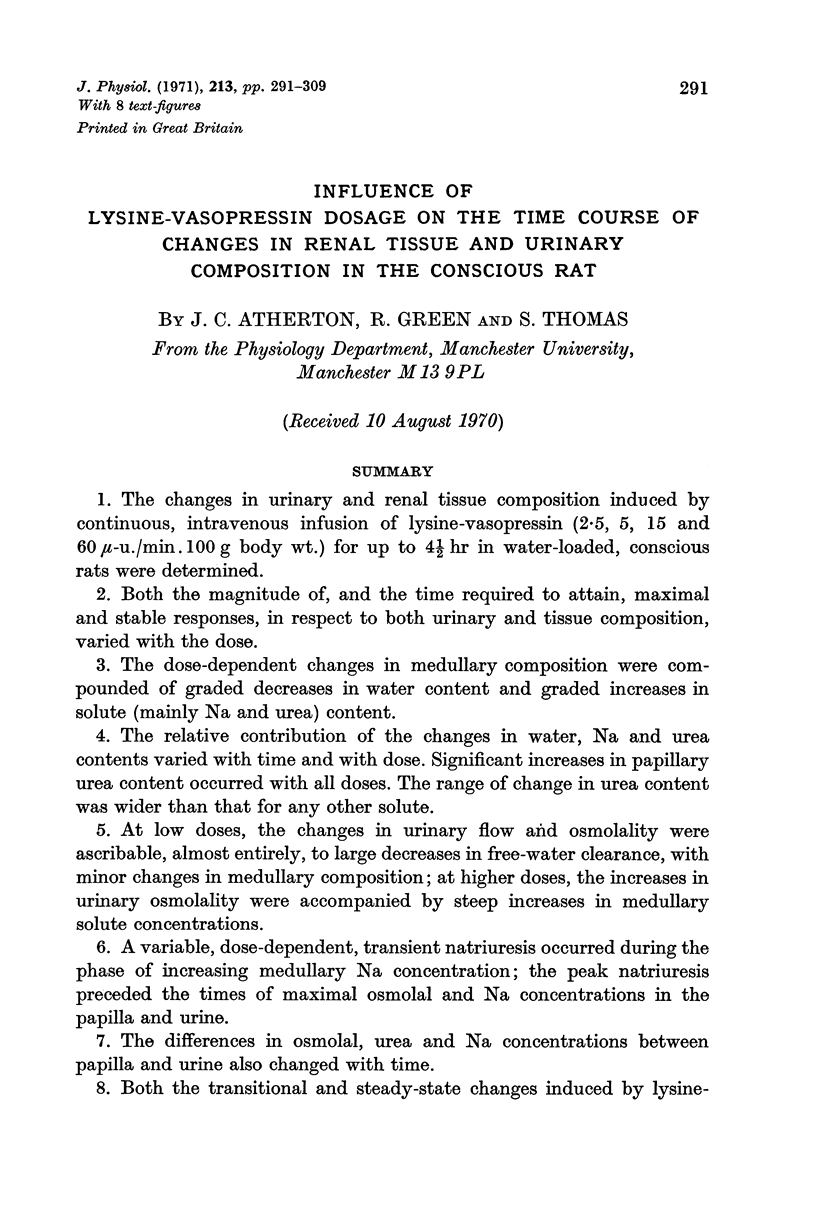
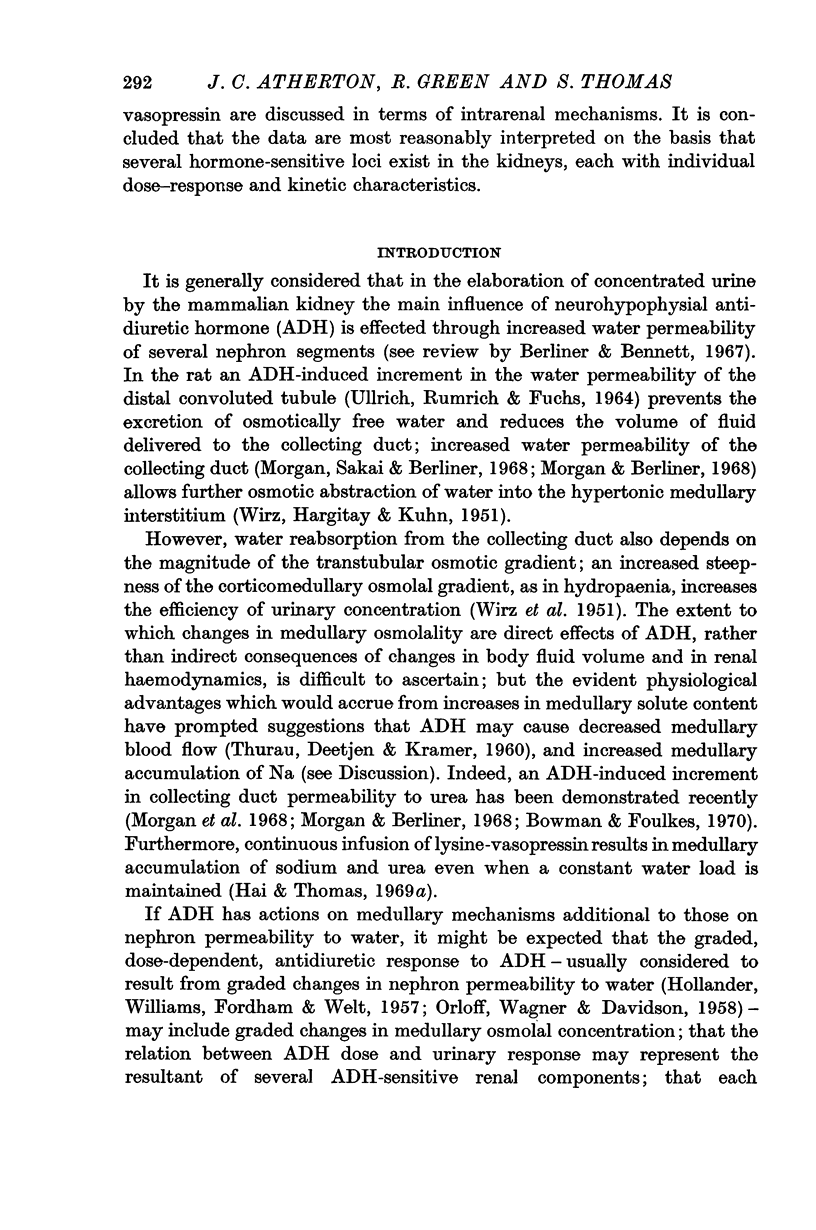


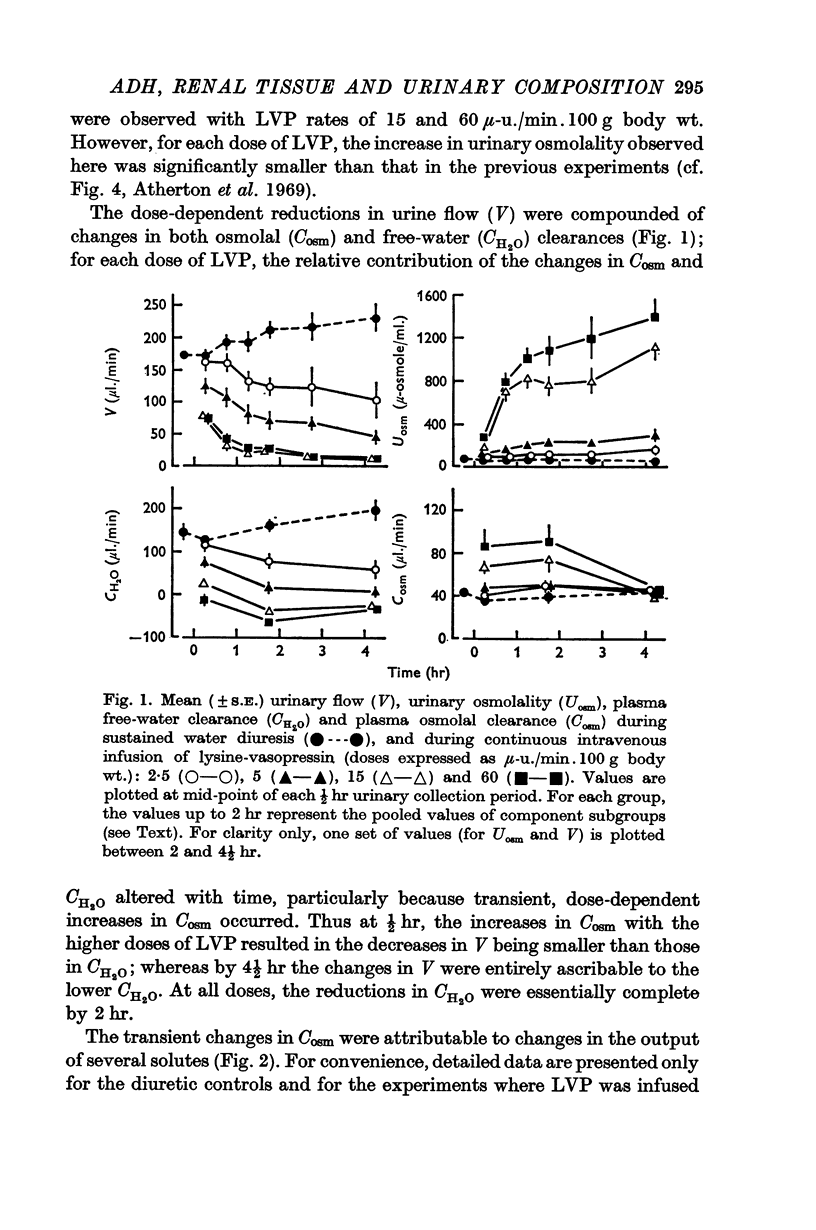
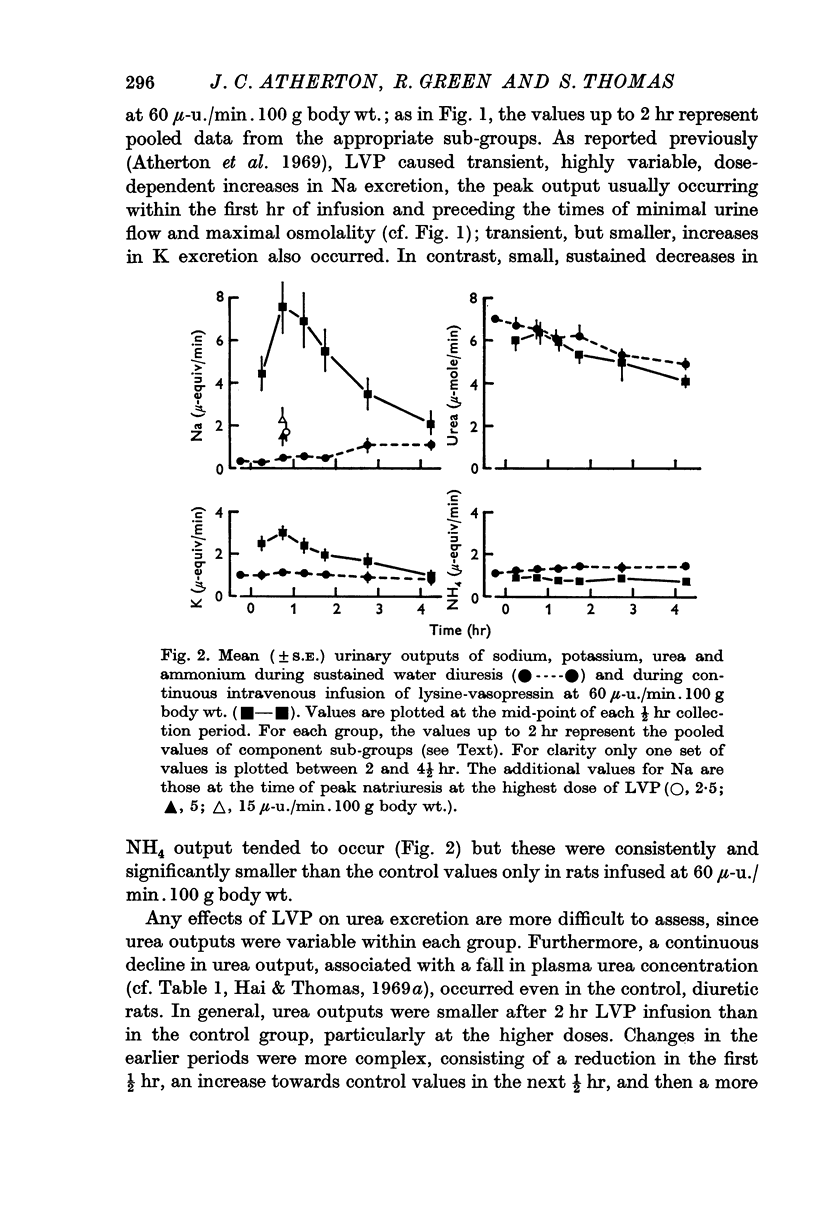



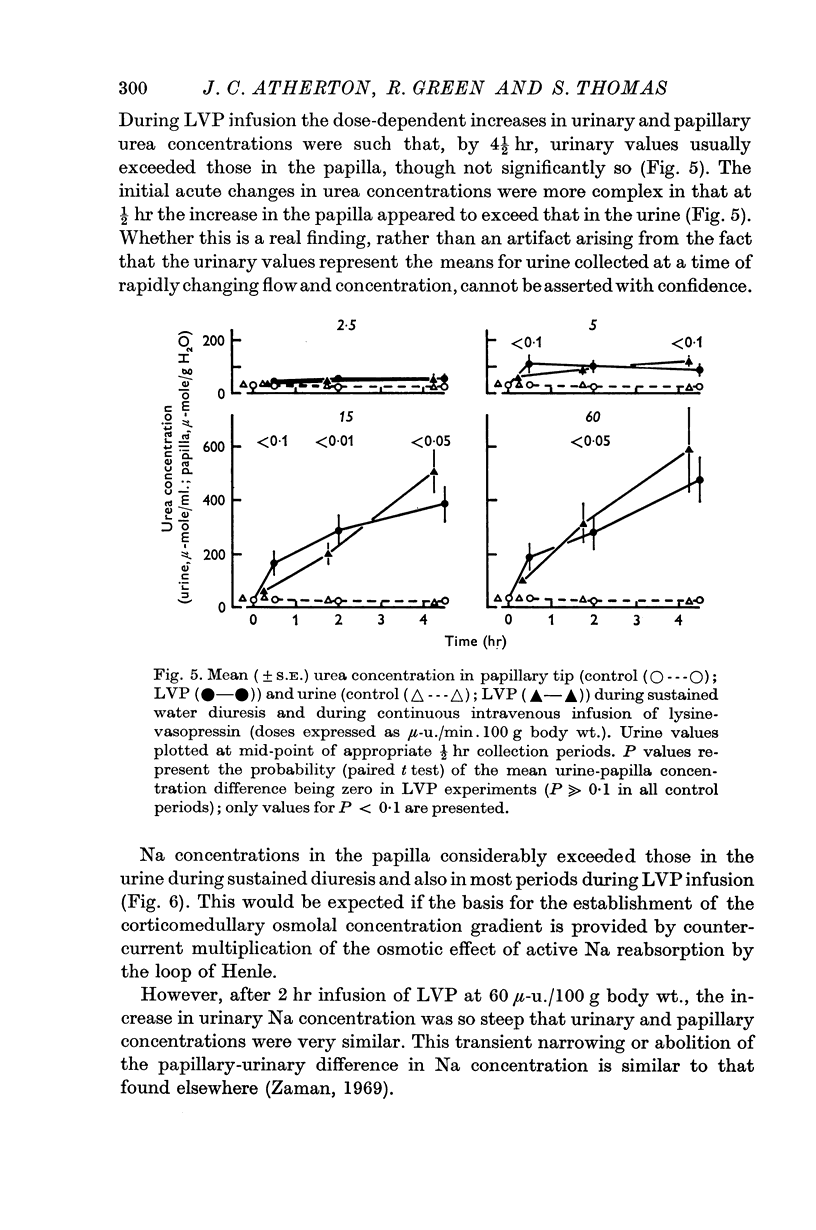
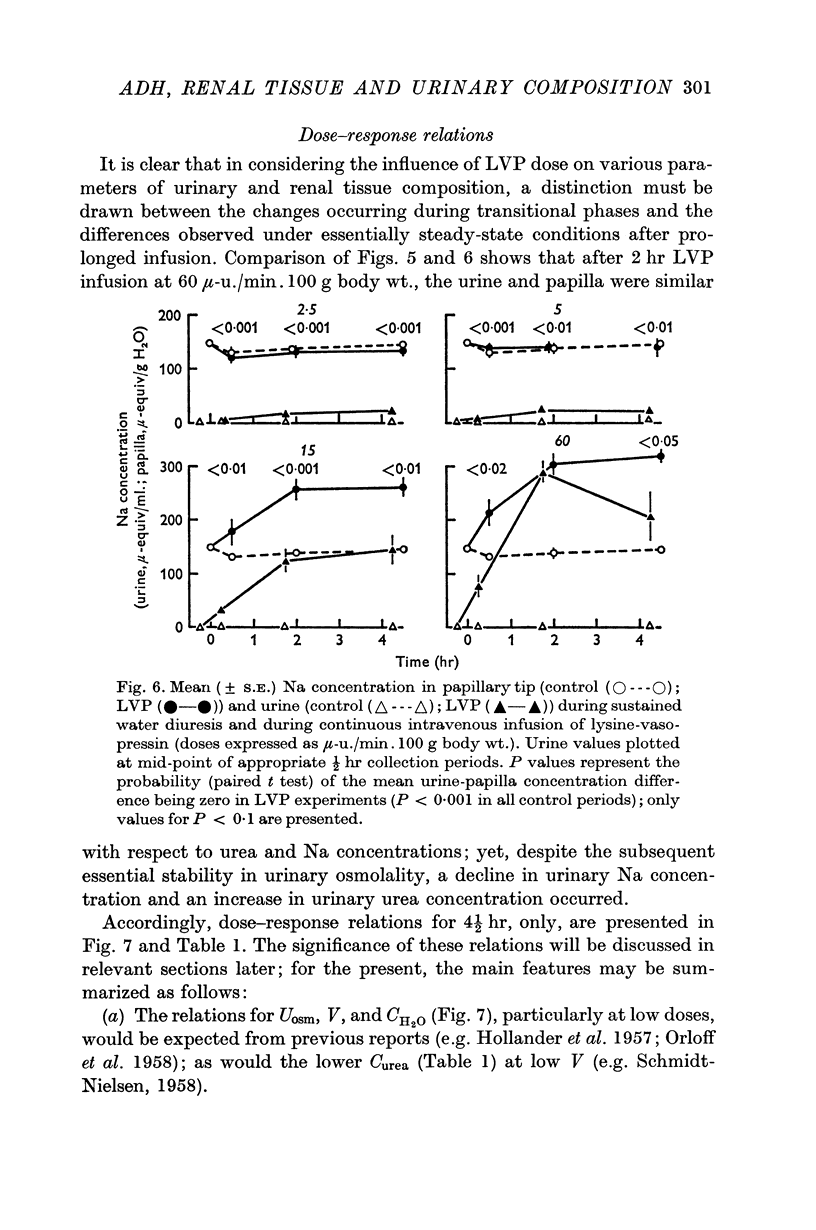

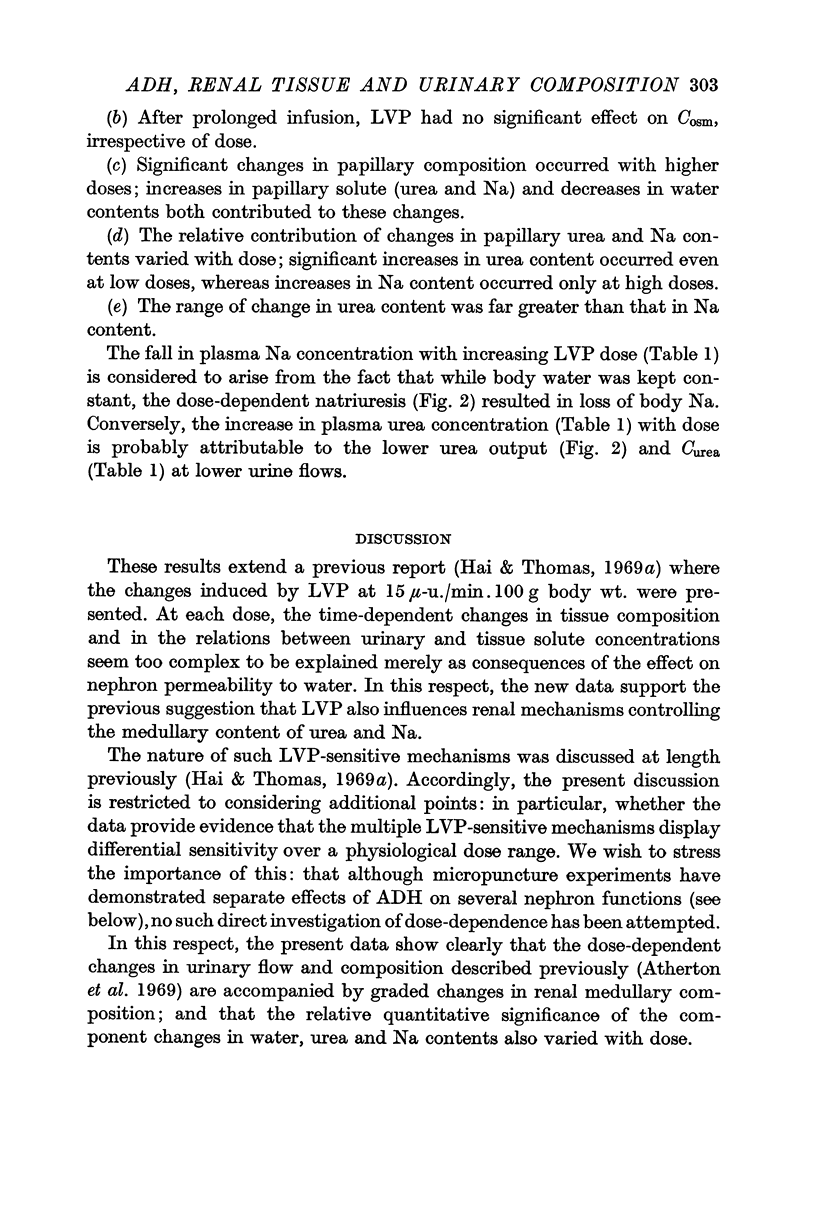

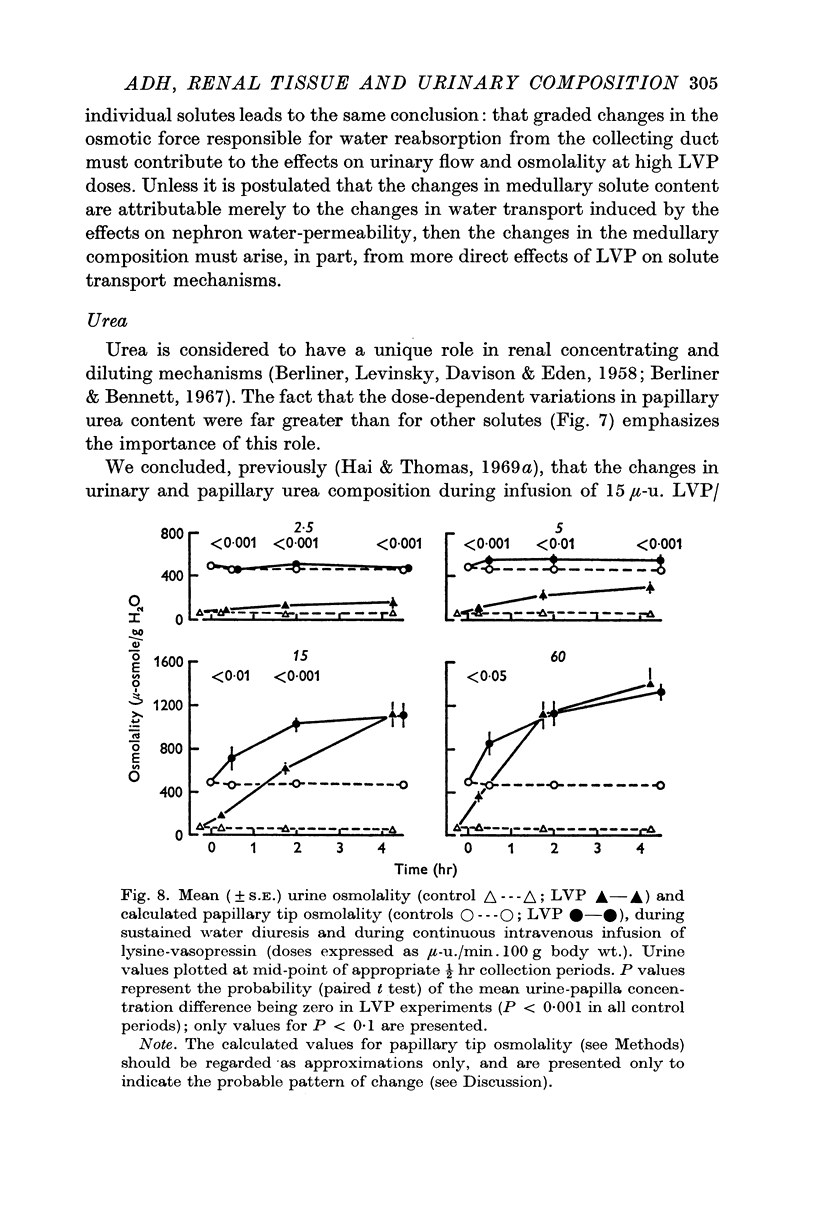




Selected References
These references are in PubMed. This may not be the complete list of references from this article.
- Atherton J. C., Evans J. A., Green R., Thomas S. Influence of variations in hydration and in solute excretion of the effects of lysine-vasopressin infusion on urinary and renal tissue composition in the conscious rat. J Physiol. 1971 Mar;213(2):311–327. doi: 10.1113/jphysiol.1971.sp009384. [DOI] [PMC free article] [PubMed] [Google Scholar]
- Atherton J. C., Green R., Hai M. A. Evaluation of a method for weighing small tissue samples: investigations into freezing and evaporation. Pflugers Arch. 1969;309(3):203–211. doi: 10.1007/BF00586798. [DOI] [PubMed] [Google Scholar]
- Atherton J. C., Green R., Thomas S. Effects of 0-9 per cent saline infusion on urinary and renal tissue composition in the hydropaenic, normal and hydrated conscious rat. J Physiol. 1970 Sep;210(1):45–71. doi: 10.1113/jphysiol.1970.sp009195. [DOI] [PMC free article] [PubMed] [Google Scholar]
- Atherton J. C., Green R., Thomas S. Effects of lysine-vasopressin dosage on renal tissue and urinary composition in the conscious, water diuretic rat. J Physiol. 1970 Jun;208(2):68P–69P. [PubMed] [Google Scholar]
- Atherton J. C., Hai M. A., Thomas S. Acute effects of lysine vasopressin injection (single and continuous) on urinary composition in the conscious water diuretic rat. Pflugers Arch. 1969;310(4):281–296. doi: 10.1007/BF00587240. [DOI] [PubMed] [Google Scholar]
- Atherton J. C., Hai M. A., Thomas S. Effects of water diuresis and osmotic (mannitol) diuresis on urinary solute excretion by the conscious rat. J Physiol. 1968 Jul;197(2):395–410. doi: 10.1113/jphysiol.1968.sp008566. [DOI] [PMC free article] [PubMed] [Google Scholar]
- Atherton J. C., Hai M. A., Thomas S. The time course of changes in renal tissue composition during mannitol diuresis in the rat. J Physiol. 1968 Jul;197(2):411–428. doi: 10.1113/jphysiol.1968.sp008567. [DOI] [PMC free article] [PubMed] [Google Scholar]
- Atherton J. C., Hai M. A., Thomas S. The time course of changes in renal tissue composition duruig water diuresis in the rat. J Physiol. 1968 Jul;197(2):429–443. doi: 10.1113/jphysiol.1968.sp008568. [DOI] [PMC free article] [PubMed] [Google Scholar]
- BERLINER R. W., LEVINSKY N. G., DAVIDSON D. G., EDEN M. Dilution and concentration of the urine and the action of antidiuretic hormone. Am J Med. 1958 May;24(5):730–744. doi: 10.1016/0002-9343(58)90377-2. [DOI] [PubMed] [Google Scholar]
- Bennett C. M., Brenner B. M., Berliner R. W. Micropuncture study of nephron function in the rhesus monkey. J Clin Invest. 1968 Jan;47(1):203–216. doi: 10.1172/JCI105710. [DOI] [PMC free article] [PubMed] [Google Scholar]
- Berliner R. W., Bennett C. M. Concentration of urine in the mammalian kidney. Am J Med. 1967 May;42(5):777–789. doi: 10.1016/0002-9343(67)90095-2. [DOI] [PubMed] [Google Scholar]
- Bowman F. J., Foulkes E. C. Antidiuretic hormone and urea permeability of collecting ducts. Am J Physiol. 1970 Jan;218(1):231–233. doi: 10.1152/ajplegacy.1970.218.1.231. [DOI] [PubMed] [Google Scholar]
- Clapp J. R., Robinson R. R. Osmolality of distal tubular fluid in the dog. J Clin Invest. 1966 Dec;45(12):1847–1853. doi: 10.1172/JCI105488. [DOI] [PMC free article] [PubMed] [Google Scholar]
- Diamond J. M., Bossert W. H. Standing-gradient osmotic flow. A mechanism for coupling of water and solute transport in epithelia. J Gen Physiol. 1967 Sep;50(8):2061–2083. doi: 10.1085/jgp.50.8.2061. [DOI] [PMC free article] [PubMed] [Google Scholar]
- HOLLANDER W., Jr, WILLIAMS T. F., FORDHAM C. C., 3rd, WELT L. G. A study of the quantitative relationship between antidiuretic hormone (vasopressin) and the renal tubular reabsorption of water. J Clin Invest. 1957 Jul;36(7):1059–1071. doi: 10.1172/JCI103501. [DOI] [PMC free article] [PubMed] [Google Scholar]
- Hai M. A., Thomas S. Influence of prehydration on the changes in renal tissue composition induced by water diuresis in the rat. J Physiol. 1969 Dec;205(3):599–618. doi: 10.1113/jphysiol.1969.sp008985. [DOI] [PMC free article] [PubMed] [Google Scholar]
- Hai M. A., Thomas S. The time-course of changes in renal tissue composition during lysine vasopressin infusion in the rat. Pflugers Arch. 1969;310(4):297–317. doi: 10.1007/BF00587241. [DOI] [PubMed] [Google Scholar]
- LAMDIN E. Mechanisms of urinary concentration and dilution. AMA Arch Intern Med. 1959 Apr;103(4):644–671. doi: 10.1001/archinte.1959.00270040130015. [DOI] [PubMed] [Google Scholar]
- Leaf A. Membrane effects of antidiuretic hormone. Am J Med. 1967 May;42(5):745–756. doi: 10.1016/0002-9343(67)90092-7. [DOI] [PubMed] [Google Scholar]
- Marsh D. J. Solute and water flows in thin limbs of Henle's loop in the hamster kidney. Am J Physiol. 1970 Mar;218(3):824–831. doi: 10.1152/ajplegacy.1970.218.3.824. [DOI] [PubMed] [Google Scholar]
- Morgan T., Berliner R. W. Permeability of the loop of Henle, vasa recta, and collecting duct to water, urea, and sodium. Am J Physiol. 1968 Jul;215(1):108–115. doi: 10.1152/ajplegacy.1968.215.1.108. [DOI] [PubMed] [Google Scholar]
- Morgan T., Sakai F., Berliner R. W. In vitro permeability of medullary collecting ducts to water and urea. Am J Physiol. 1968 Mar;214(3):574–581. doi: 10.1152/ajplegacy.1968.214.3.574. [DOI] [PubMed] [Google Scholar]
- ORLOFF J., WAGNER H. N., Jr, DAVIDSON D. G. The effect of variations in solute excretion and vasopressin dosage on the excretion of water in the dog. J Clin Invest. 1958 Mar;37(3):458–464. doi: 10.1172/JCI103625. [DOI] [PMC free article] [PubMed] [Google Scholar]
- SAIKIA T. C. COMPOSITION OF THE RENAL CORTEX AND MEDULLA OF RATS DURING WATER DIURESIS AND ANTIDIURESIS. Q J Exp Physiol Cogn Med Sci. 1965 Apr;50:146–157. doi: 10.1113/expphysiol.1965.sp001777. [DOI] [PubMed] [Google Scholar]
- SCHMIDT-NIELSEN B. Urea excretion in mammals. Physiol Rev. 1958 Apr;38(2):139–168. doi: 10.1152/physrev.1958.38.2.139. [DOI] [PubMed] [Google Scholar]
- Schnermann J., Valtin H., Thurau K., Nagel W., Horster M., Fischbach H., Wahl M., Liebau G. Micropuncture studies on the influence of antidiuretic hormone on tubular fluid reabsorption in rats with hereditary diabetes insipidus. Pflugers Arch. 1969;306(2):103–118. doi: 10.1007/BF00586878. [DOI] [PubMed] [Google Scholar]
- THURAU K., DEETJEN P., KRAMER K. [Hemodynamics of kidney medullary substance. Part II. Interrelationships between the vascular and tubular counter-flow system in arterial pressure increases, water diuresis and osmotic diuresis]. Pflugers Arch Gesamte Physiol Menschen Tiere. 1960;270:270–285. [PubMed] [Google Scholar]
- ULLRICH K. J., RUMRICH G., FUCHS G. WASSERPERMEABILITAET UND TRANDTUBULAERER WASSERFLUSS CORTICALER NEPHRONABSCHNITTE BEI VERSCHIEDENEN DIURESEZUSTAENDEN. Pflugers Arch Gesamte Physiol Menschen Tiere. 1964 Jul 1;280:99–119. [PubMed] [Google Scholar]
- Ullrich K. J., Baldamus C. A., Uhlich E., Rumrich G. Einfluss von Calciumionen und antidiuretischem Hormon auf den transtubulären Natriumtransport in der Rattenniere. Pflugers Arch. 1969;310(4):369–376. doi: 10.1007/BF00587245. [DOI] [PubMed] [Google Scholar]
- WIRZ H., HARGITAY B., KUHN W. Lokalisation des Konzentrierungsprozesses in der Niere durch direkte Kryoskopie. Helv Physiol Pharmacol Acta. 1951 Jun;9(2):196–207. [PubMed] [Google Scholar]


